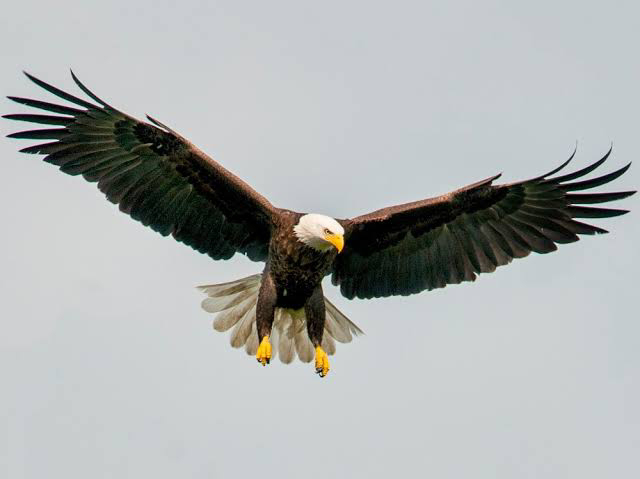The Majestic Bald Eagle: Symbol of Strength and Freedom
Introduction:
The bald eagle, with its iconic appearance and powerful symbolism, is a bird that has captivated the hearts and minds of people around the world. As the national bird and symbol of the United States, the bald eagle holds a special place in American culture and history. In this article, we will explore the characteristics, habitat, behavior, and conservation status of this magnificent raptor.
Characteristics and Appearance:
The bald eagle (Haliaeetus leucocephalus) is a large bird of prey belonging to the family Accipitridae. It is instantly recognizable by its striking white head, contrasting with a dark brown body. Adults typically measure between 28 to 40 inches (71 to 101 cm) in length and have a wingspan of 6 to 8 feet (1.8 to 2.4 meters). Females are slightly larger than males, weighing between 10 to 14 pounds (4.5 to 6.3 kg), while males weigh around 6 to 9 pounds (2.7 to 4 kg).
Habitat and Distribution:
Bald eagles are found primarily in North America, ranging from Alaska to the northern parts of Mexico. They inhabit diverse habitats, including forests, wetlands, and coastal areas. These birds prefer areas near large bodies of water, such as lakes, rivers, and coastlines, as they rely on fish as a primary food source. Bald eagles are also known to migrate, with some individuals traveling long distances to find suitable feeding grounds.
Behavior and Adaptations:
One of the most remarkable characteristics of bald eagles is their incredible eyesight. Their sharp, yellow eyes allow them to spot prey from great distances while soaring high in the sky. They have a keen sense of hearing as well, enabling them to detect the movements of potential prey or competitors.
Bald eagles are formidable hunters and primarily feed on fish, but they also consume small mammals, waterfowl, and carrion. They use their powerful talons to snatch fish from the water's surface or steal prey from other birds. These raptors are skilled flyers, capable of reaching speeds of up to 40 miles per hour (64 kilometers per hour) and soaring at altitudes of several thousand feet.
Breeding and Conservation:
Bald eagles are known for their elaborate courtship displays, often engaging in aerial acrobatics and calling to attract a mate. They typically mate for life, with pairs returning to the same nesting site year after year. The large nests, called "eyries," are built on tall trees or cliffs near water bodies. Over time, the nests can grow to immense sizes, weighing up to a ton.
While the bald eagle population faced significant declines due to habitat destruction, hunting, and the widespread use of pesticides like DDT in the mid-20th century, conservation efforts have successfully helped in their recovery. The bald eagle was removed from the endangered species list in 2007, thanks to the concerted efforts of conservationists, wildlife agencies, and concerned citizens.
Symbolism and Cultural Significance:
Beyond its biological significance, the bald eagle holds great symbolism, representing strength, freedom, and resilience. It has been an emblem of the United States since 1782 when it was chosen as the national bird. The eagle's image is found on numerous U.S. symbols, including the Great Seal, currency, and government insignia. It serves as a reminder of the nation's values and ideals.
Conclusion:
The bald eagle stands as a testament to the power and beauty of the natural world. Its majestic appearance, impressive hunting abilities, and symbolic value have made it an enduring icon. Through successful conservation efforts, this magnificent bird has made a remarkable


.jpeg)
Comments
Post a Comment